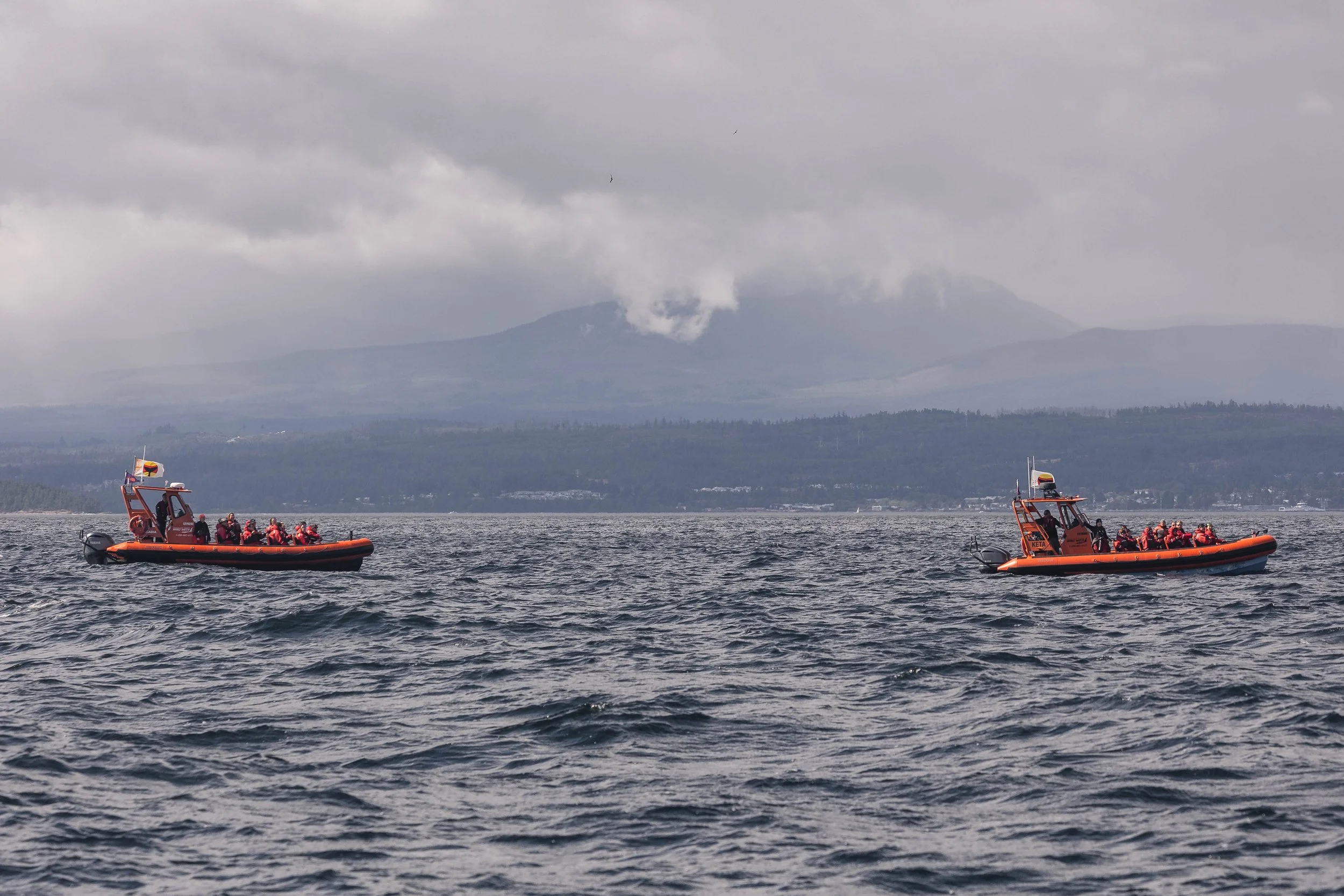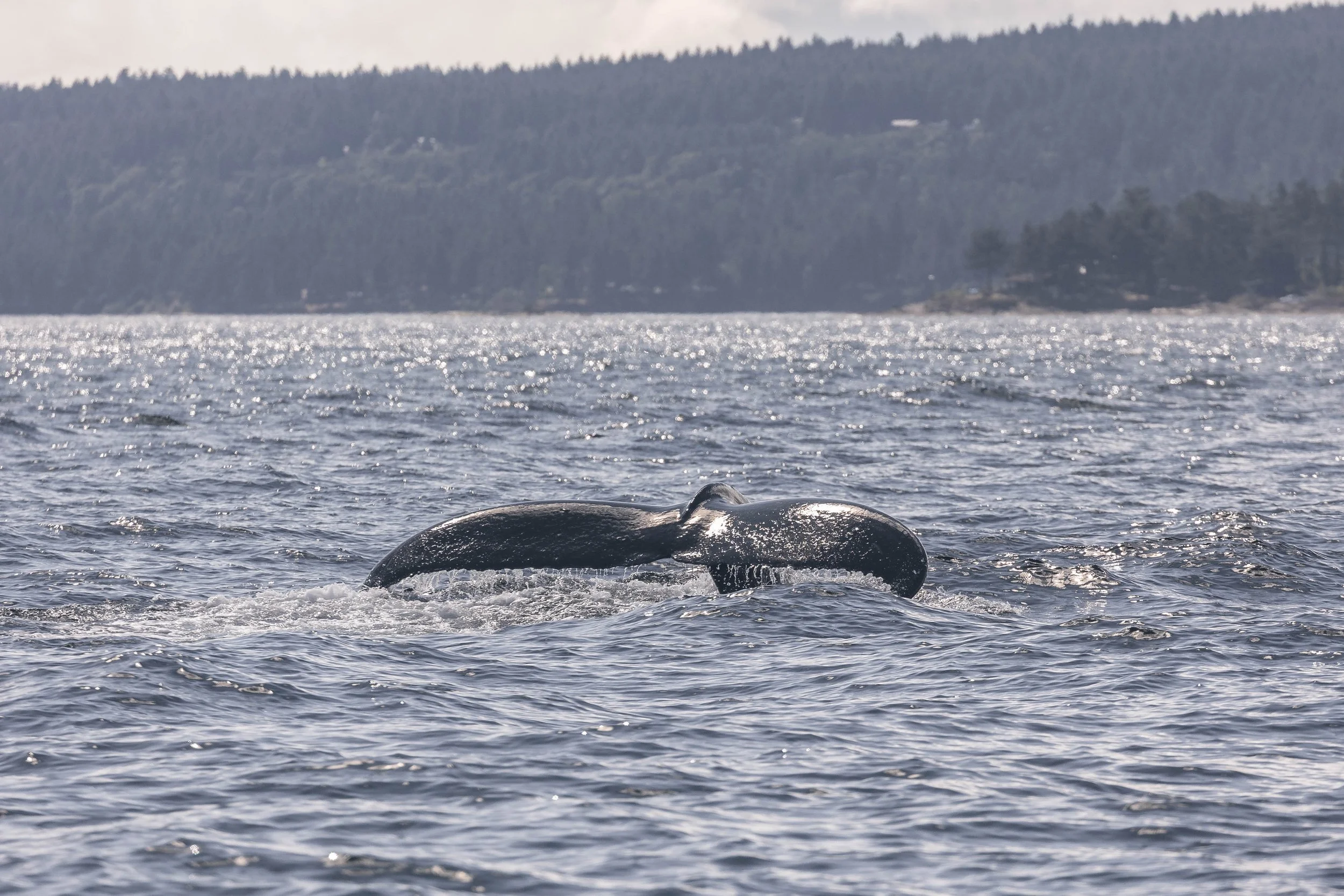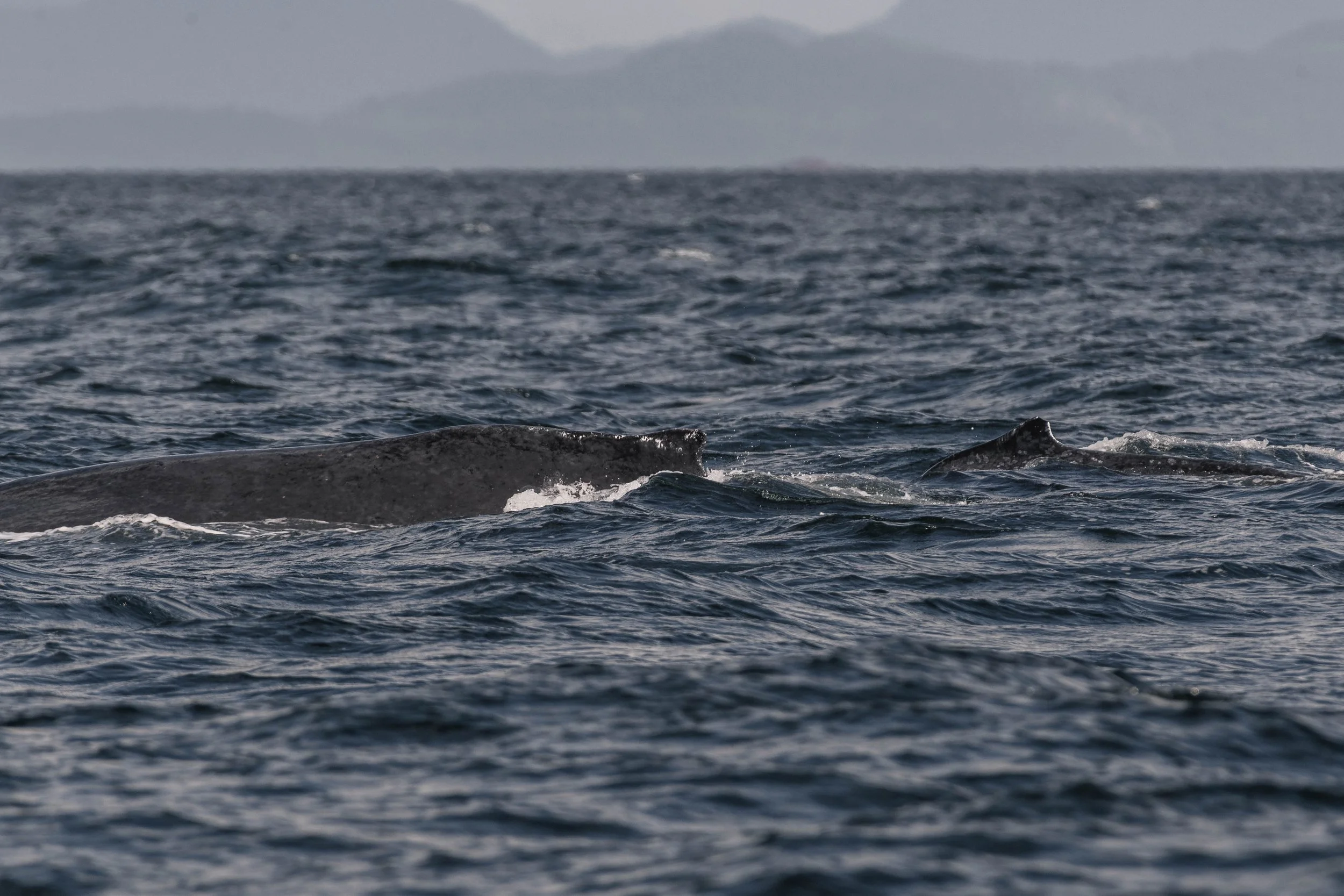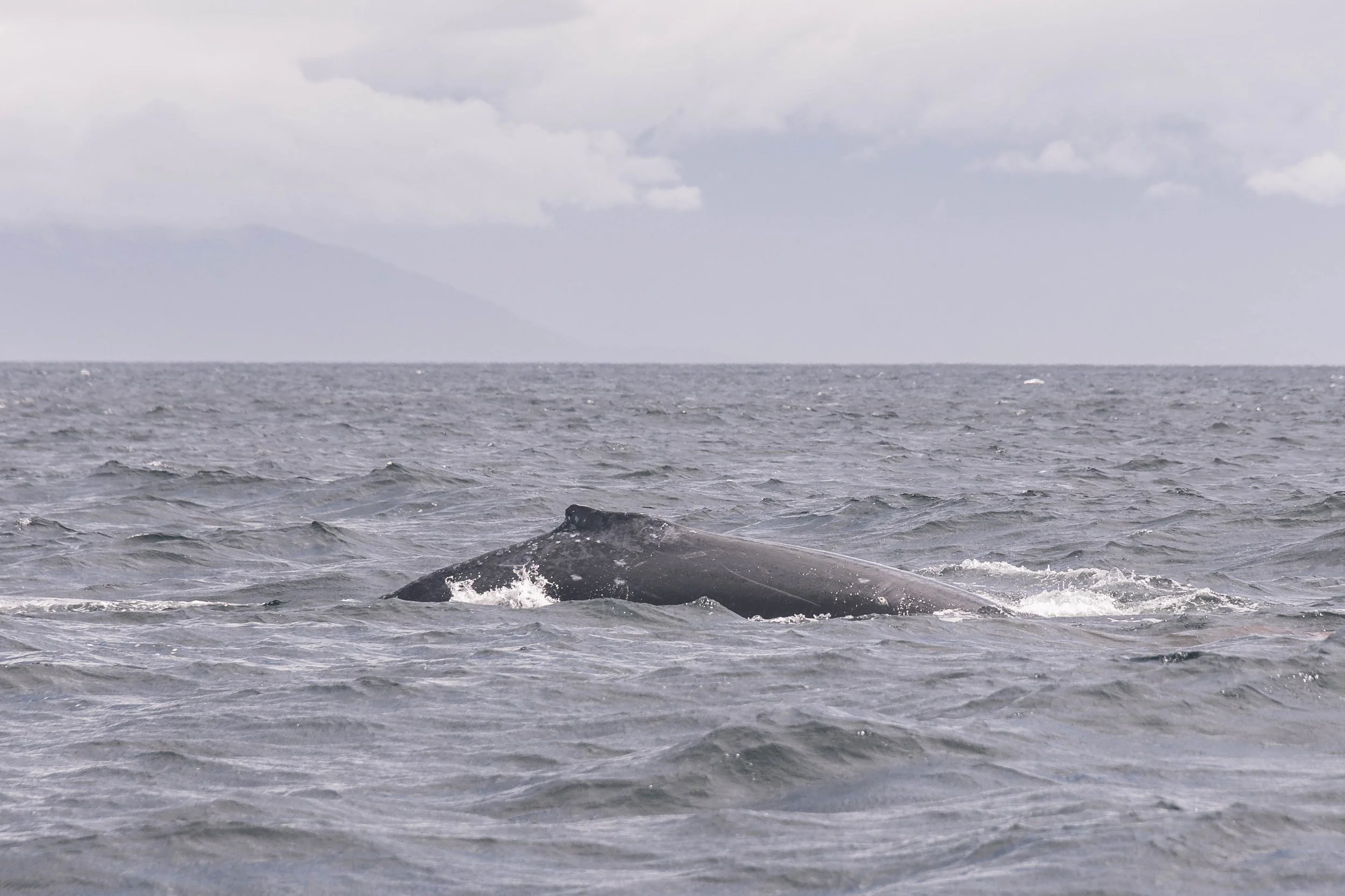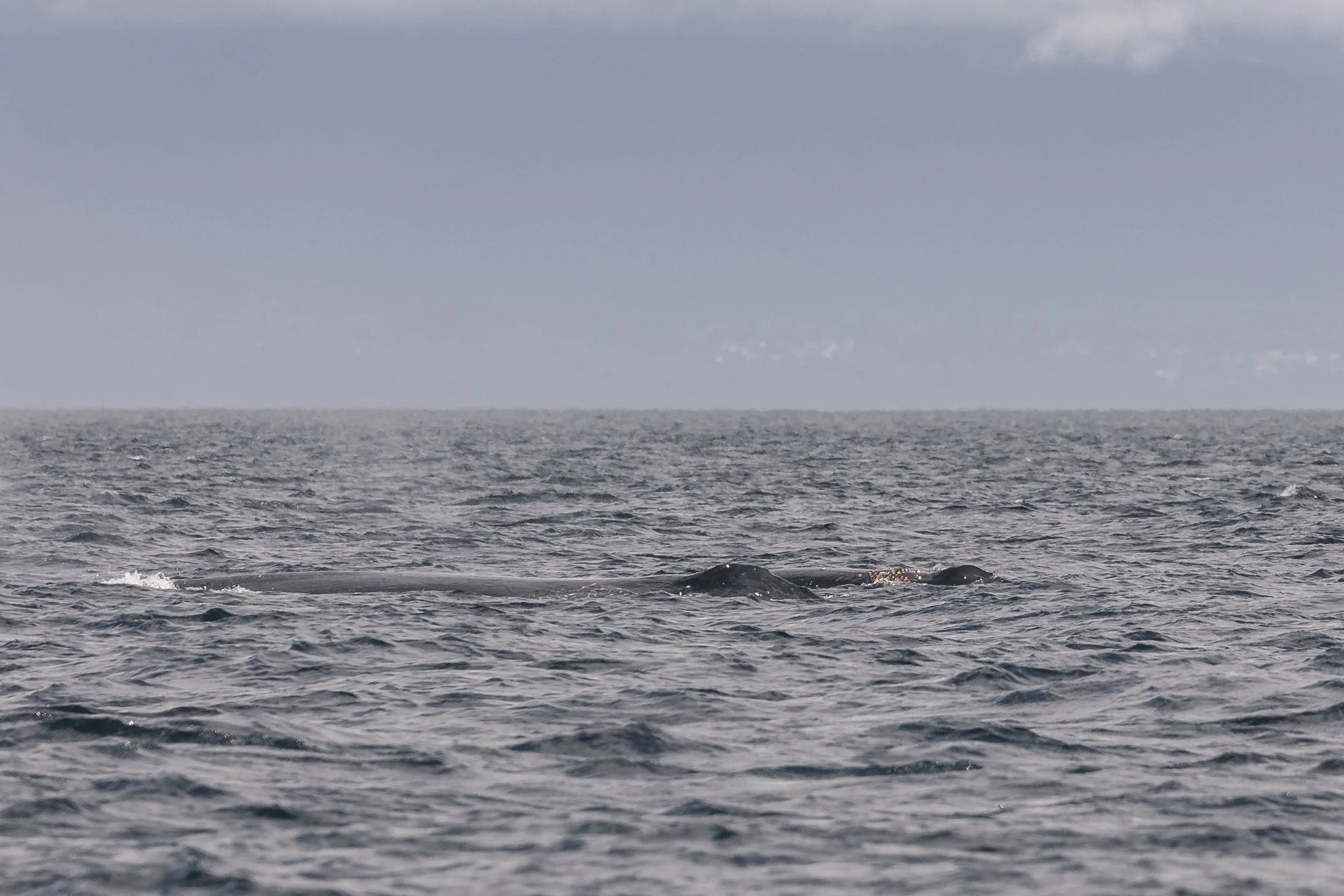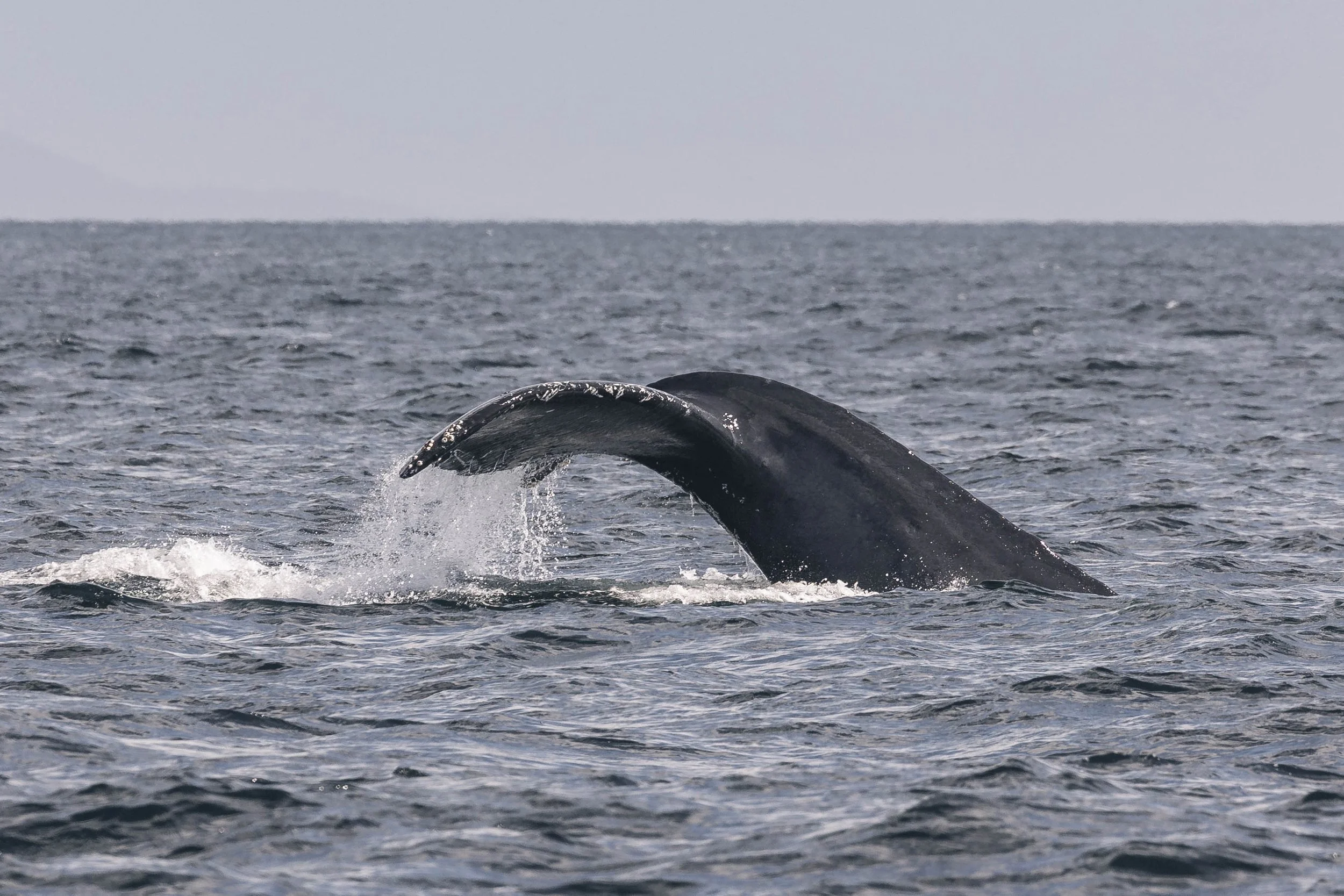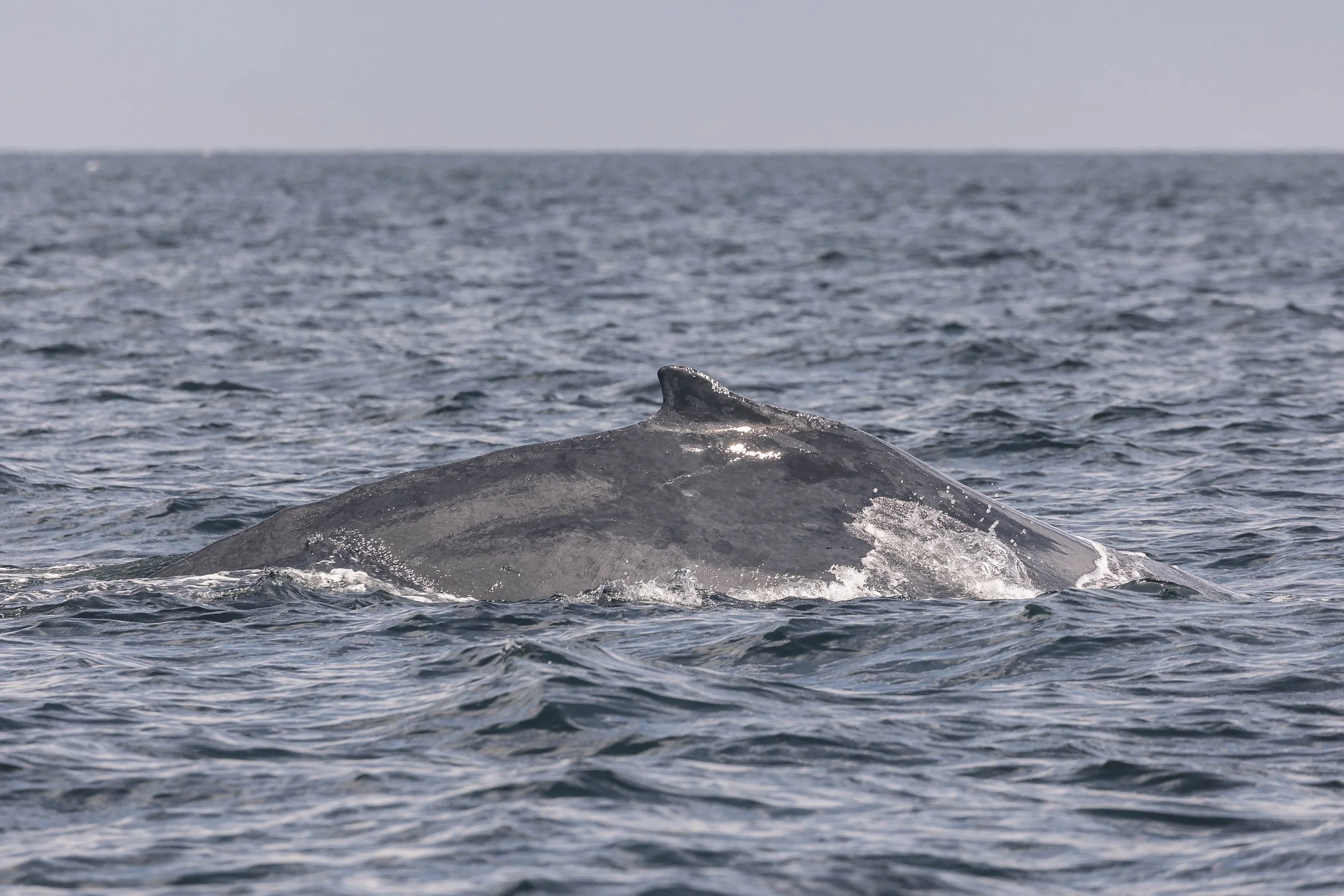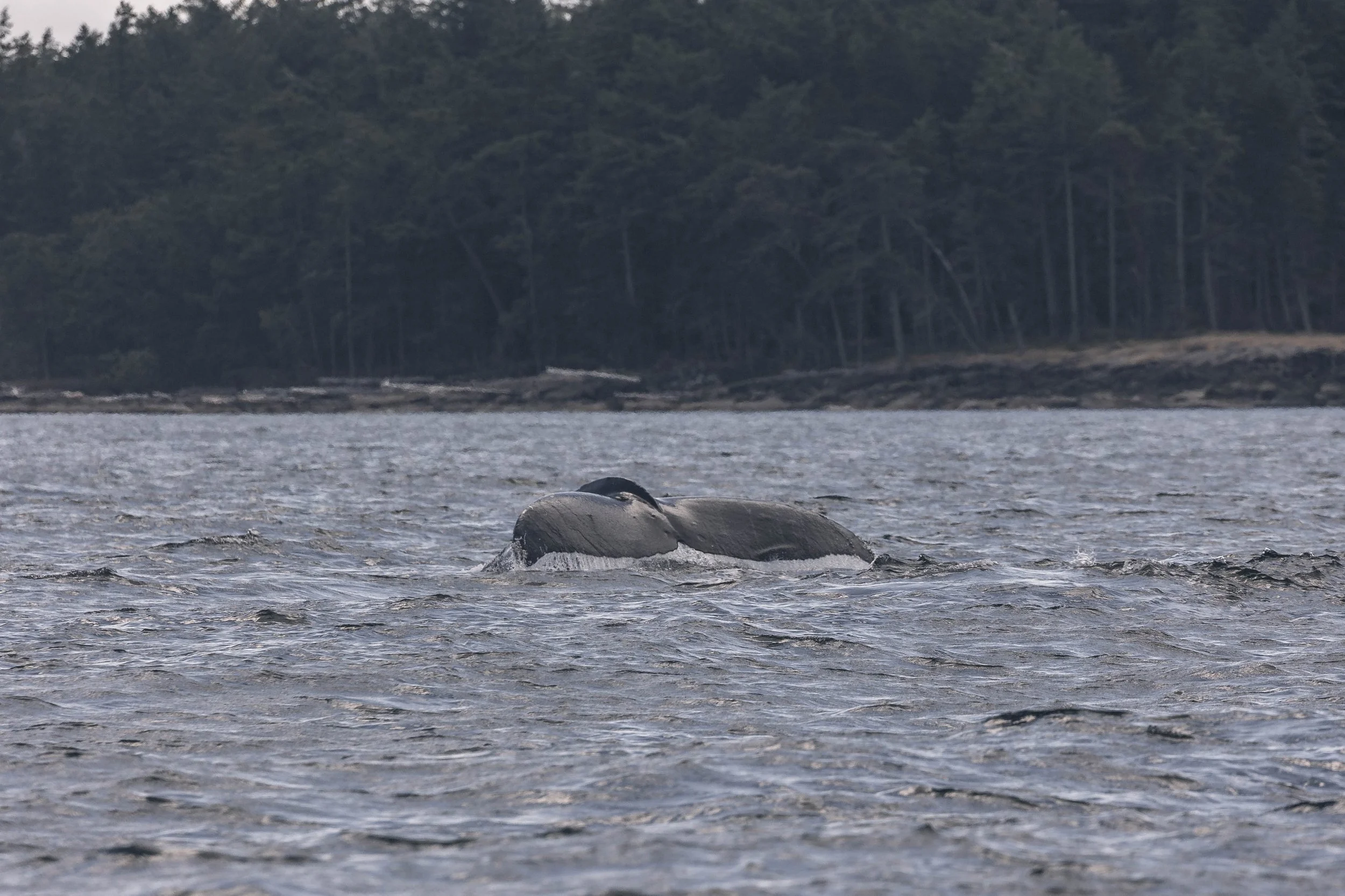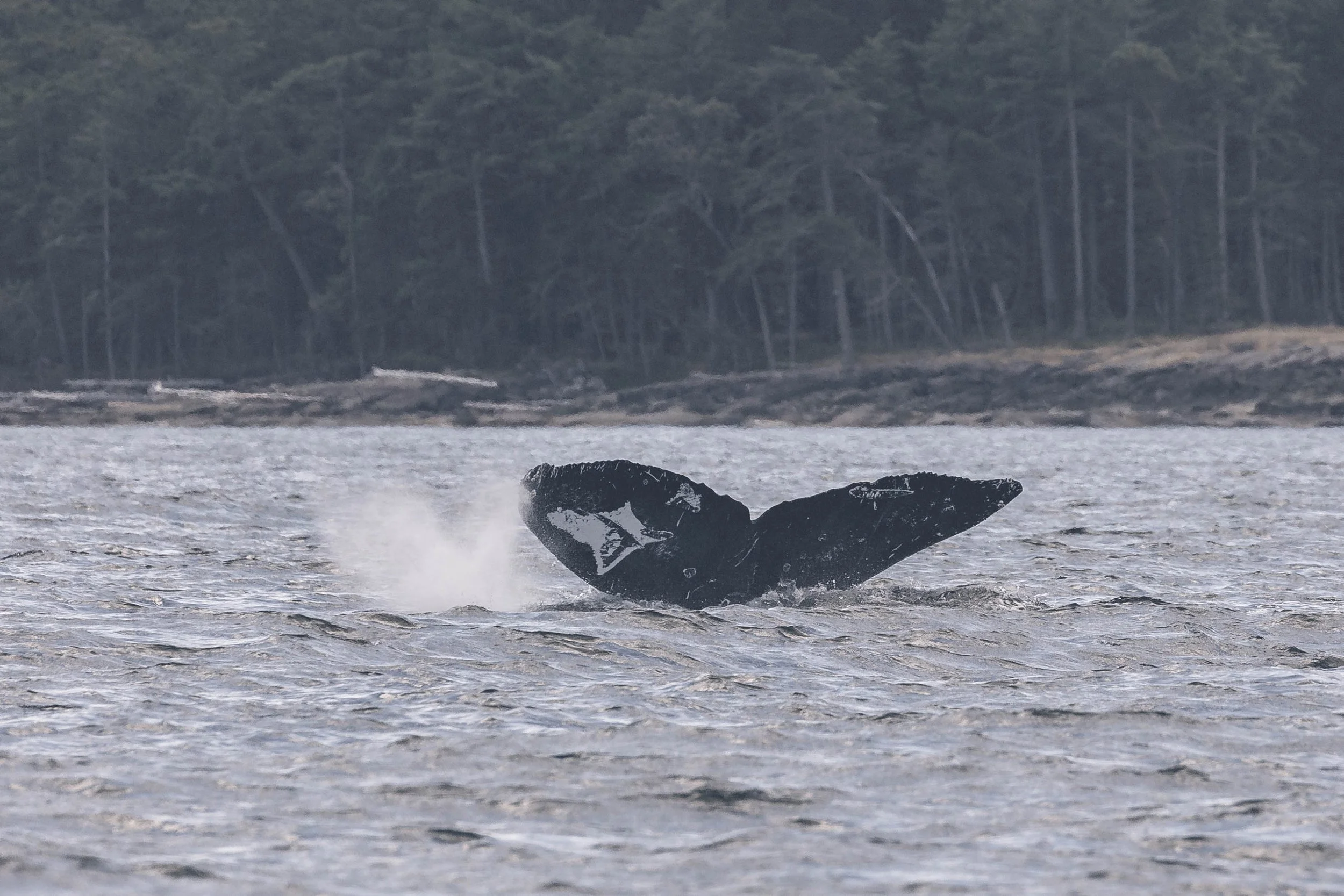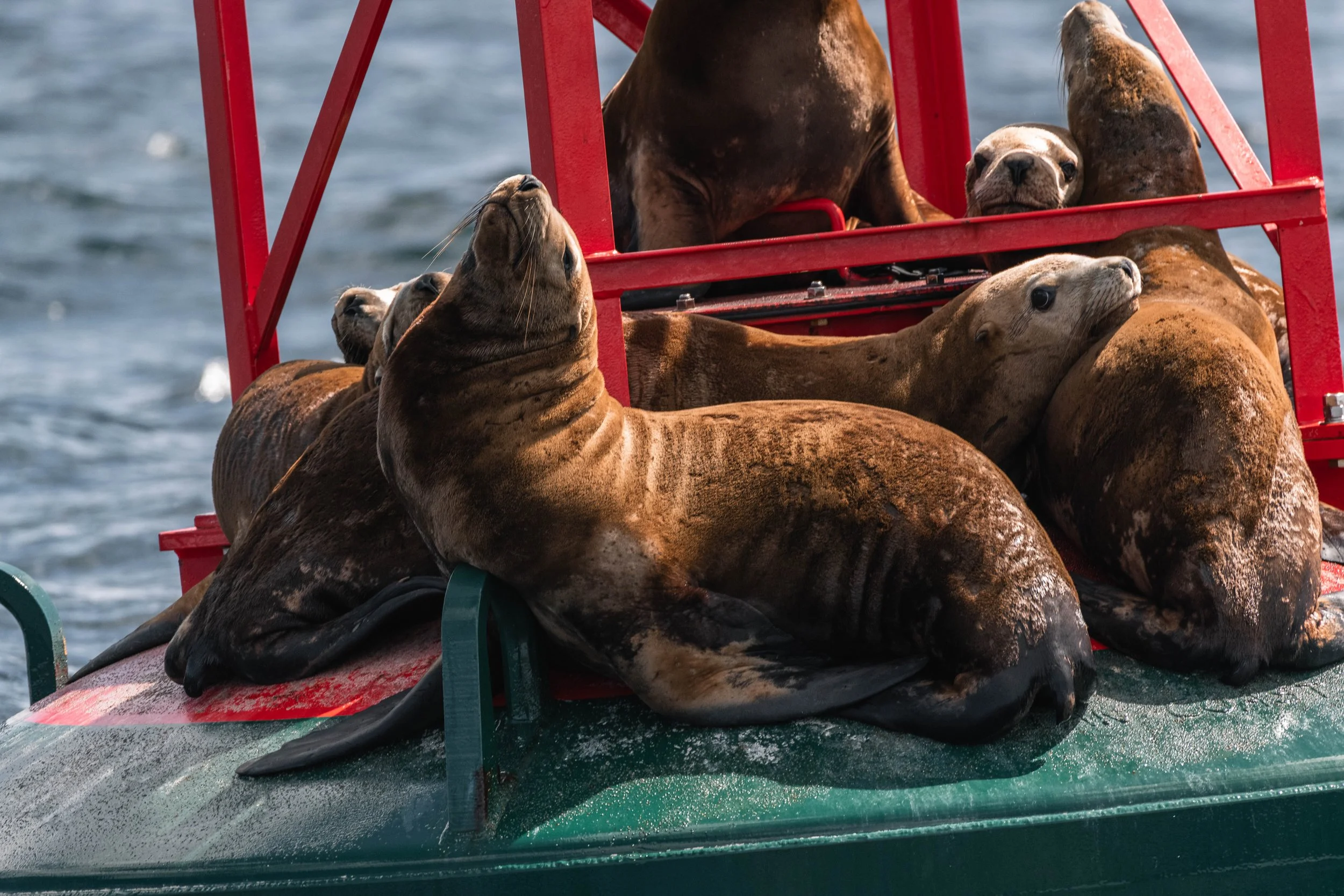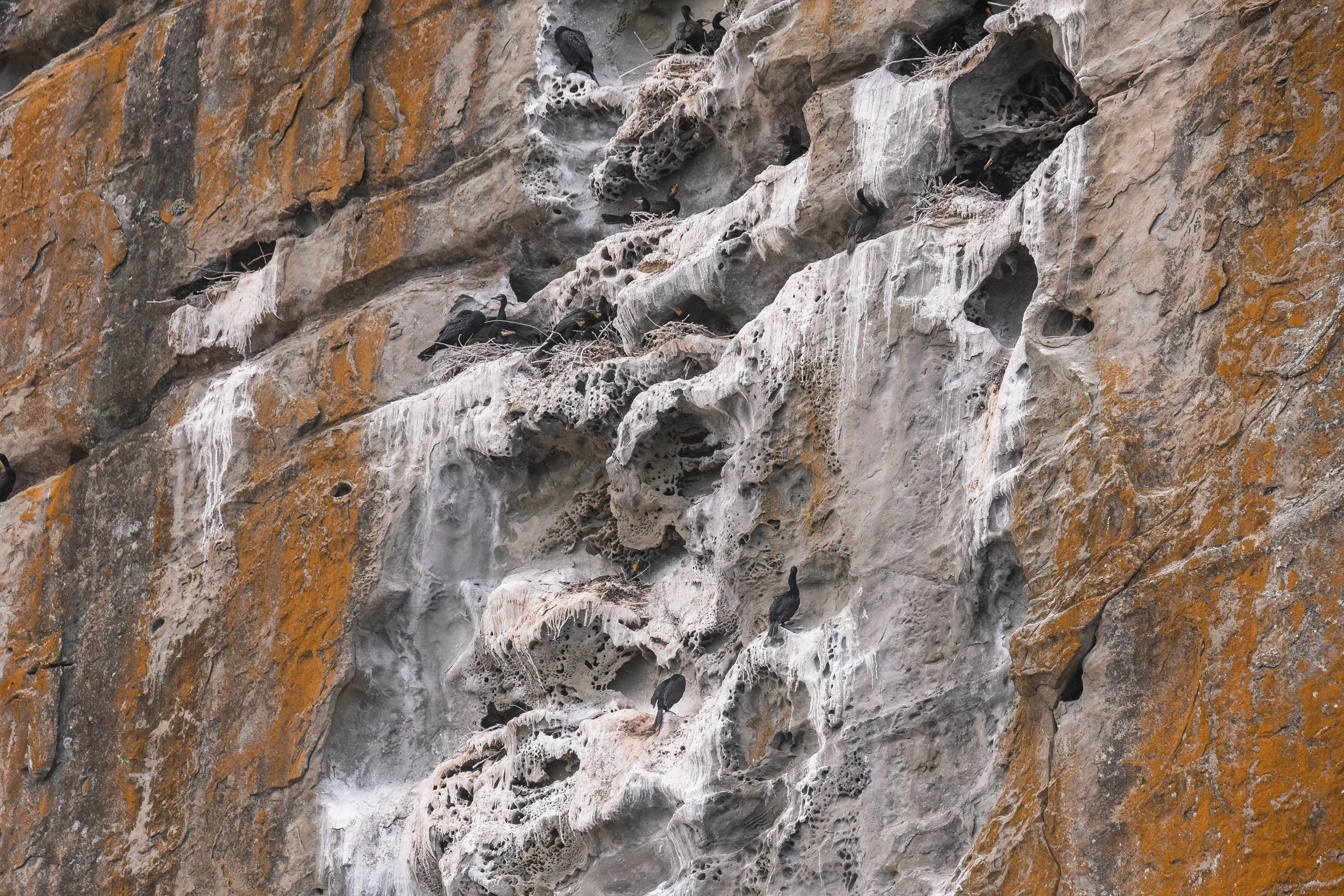August 16, 2025, 10:30 AM - Kappa and her calf make a new friend
We had another amazing day of whale watching in store for us today, with five humpback whales to be spotted! It started with all three of our boats heading into the Salish Sea, or more particularly, the Strait of Georgia, to start their search. Each tour starts fresh each day, not knowing what we are going to find, where we might find it, or even if we are going to find anything at all, given that all whales, and most marine mammals in general, are free of any trackers or tags! Heading out on the water, we rely on our knowledge of the whales, our great eyesight, and a little bit of luck in finding the whales. Luckily, these things all combined to help us find the first set of whales very quickly this morning, rounding the north end of Gabriola Island as we spotted blows in the distance! It seemed that we had found ourselves some whales!
The first encounter with the whales was with a pair of Humpbacks: Professor X (BCX1965) and Barge Boy (KEX0078). While these two weren’t travelling too close together, we did spot both of them feeding in around the same area. This is quite common with the humpback whales in particular, given that they prefer to spend their time in areas of high productivity. This makes sense, given that the humpbacks are here to feed over the summer. Trying to build up their fat reserve takes a lot of feeding success, with about 1 tonne of food consumed each day. While it’s always great to see the whales doing feeding behaviour, it can sometimes be tricky to watch, since most of the feeding occurs below the surface. This can mean long dives and sporadic surfaces, which is why we didn’t spend too much time here before continuing our search.
We travelled south-east along Gabriola Island until we once again spotted the blows of humpbacks in the distance! It seemed that this time we had a trio: Kappa (BCX0158), and Kappiroto (BCX0158calf2025), travelling with Squirrel/Smoke (BCX2183).
As time passes, we are seeing more and more associations forming between humpback whales in our waters, which is excellent, especially considering that they were once thought to be solitary creatures. There is likely a large combination of reasons for this apparent change in behaviour.
Their numbers were significantly reduced by commercial whaling in the area. Although it seems like a long time ago that whaling was happening, the last whaling station in BC (Coal Harbour) only closed in 1967. That’s only 58 years ago! In their last year of operation, this station killed 494 whales across the eight targeted species. Over their time in operation (from 1948 to 1967), 812 humpback whales were taken from our waters. You can imagine that, combined with the other five stations operating in BC, many more animals lost their lives to this practice. Luckily, commercial whaling was banned worldwide in 1986. This significant reduction in numbers likely made it more difficult for individuals to find each other, and now that their numbers are recovering, this is changing.
Humpback whales are Ecosystem Engineers! They are constantly changing the environment around them to suit themselves better. As their numbers increase again, the amount of food available to them will also increase. This increase in food availability and density will likely mean that they won’t have to spend as much of their time feeding and might start to have more time for socializing and other activities.
There might be some feeding benefit to these whales travelling together. This theory is a combination of the other two theories, as they can travel and work together to feed more efficiently than if they were alone. Before their number recovery, it just might not have had any benefit to spending time together, but if they can help each other feed, it’s a win-win all around, getting more food while being more social at the same time.
While we love speculating about why the whales might be travelling together more, we don’t really mind why they do it; it’s just a fantastic sight to see more and more of these interactions! One 17-meter-long creature feeding and lifting its massive tail as it dives is spectacular, but seeing more together is even better. We enjoyed our time with these three before it was time to continue.
We made a couple more wildlife stops on our journey back to Nanaimo, once East of Valdes Island at Stinky Rock for Harbour Seals and at UM buoy not far away to see the Steller Sea Lions hauled out there. We finished the trip at the Gabriola Bluffs, where we saw the Cormorants using the cliffs as their nesting sites.
It was a fantastic set of encounters with our wildlife, and the onboard marine naturalists Aly Kohlman, Hayleigh Hilbert, and Jordan Robinson captured these moments beautifully. You can enjoy all of their photos below!
Our two open boats watching the whales. Photo by Jordan Robinson.
Barge Boy going for a dive. Photo by Jordan Robinson.
Entrance Island Lighthouse. Photo by Jordan Robinson.
Kappa surfacing, showing off her dorsal fin. Photo by Aly Kohlman.
Kappa going for a dive. Photo by Aly Kohlman.
Kappa surfacing beside her calf. Photo by Aly Kohlman.
Kappiroto surfacing in the waves. Photo by Hayleigh Hilbert.
Kappa and Kappiroto surfacing side by side. Photo by Hayleigh Hilbert.
A great look at Kappiroto’s barnacle necklace. Photo by Hayleigh Hilbert.
Kappa and Kappiroto swimming side by side. Photo by Jordan Robinson.
Squirrel/Smoke going for a dive. Photo by Jordan Robinson.
Kappa in the back with Squirrel/Smoke in the front. Photo by Jordan Robinson.
Squirrel/Smoke’s dorsal fin. Photo by Jordan Robinson.
Kappa’s dorsal fin. Photo by Jordan Robinson.
Squirrel/Smoke making a fluke waterfall. Photo by Jordan Robinson.
The underside of Squirrel/Smoke’s tail. Photo by Jordan Robinson.
A fluke waterfall from Kappa as she dives. Photo by Jordan Robinson.
Happy Whale Watchers onboard Keta. Can you spot our other boat, Kula, in the background? Photo by Hayleigh Hilbert.
Harbour Seal lounging on the rocks. Photo by Aly Kohlman.
A Harbour Seal striking a pose. Photo by Jordan Robinson.
Steller Sea Lion watching us from the water. Photo by Jordan Robinson.
Steller Sea Lions cuddling on the UM buoy. Photo by Aly Kohlman.
A very cute Steller Sea Lion. Photo by Aly Kohlman.
Steller Sea Lions Hauled out on the UM buoy. Photo by Jordan Robinson.
A Bald Eagle taking off from the trees. Photo by Aly Kohlman.
Bird guano painting the cliffside white. Photo by Hayleigh Hilbert.
Cormorants Nesting on the bluffs. Photo by Hayleigh Hilbert.
Cormorants on the Gabriola Bluffs drying off after a swim. Photo by Jordan Robinson.
A great look at the Gabriola Bluffs. Photo by Jordan Robinson.
A Turkey Vulture soaring overhead. Photo by Hayleigh Hilbert.
Nanaimo’s Famous Bathtub Boat! Photo by Jordan Robinson.

